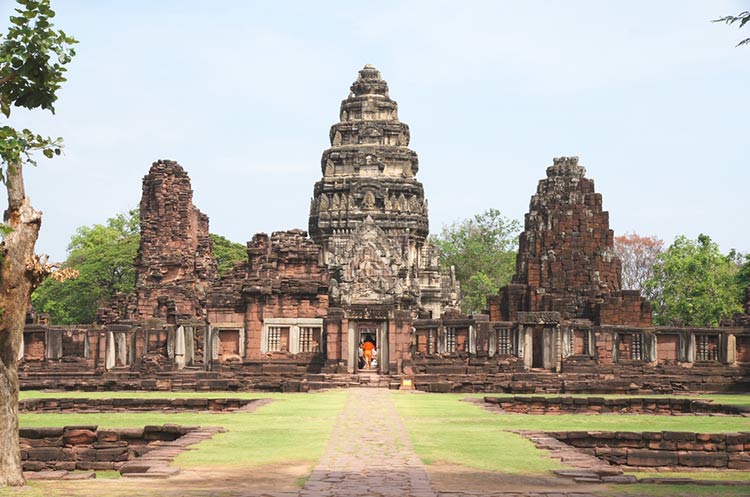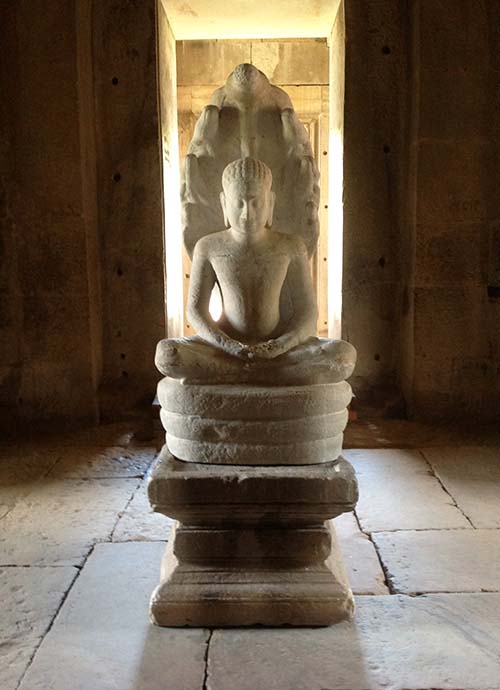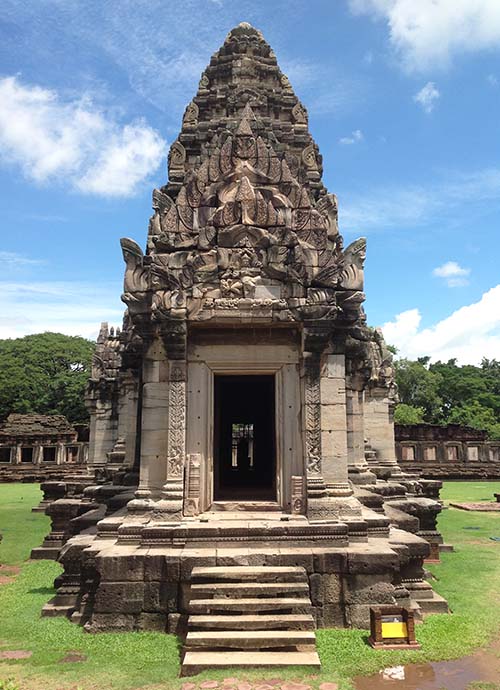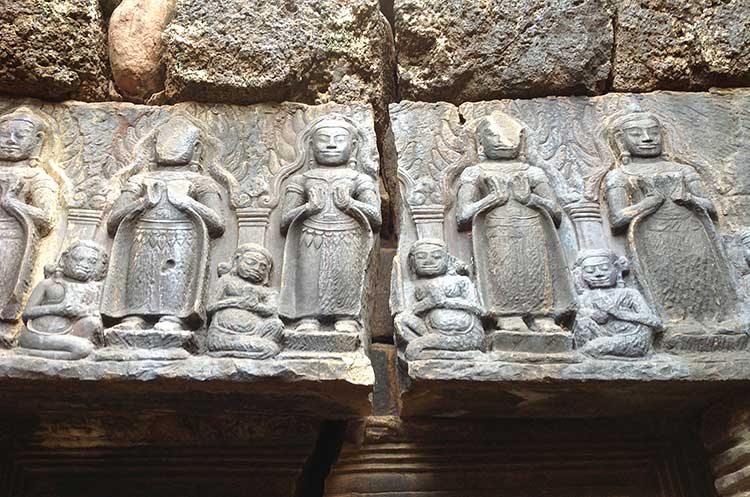Great place to stop for a few hours on your trip from Surin to Bangkok if you have some time and like these old Khmer temple ruins. I have been there a few times over the years with family and visiting friends. Nice place to see after the monsoon rains stop and it starts to cool down a bit.

Phimai, Prasat Hin Phimai
Date
11th - 12th century
Location
Phimai, Nakhon Ratchasima
Phimai historical park is the largest of all Khmer temples in Thailand, the rectangular complex measures over 1,000 meters long by almost 600 meters wide. It contains some of the finest examples of Khmer architecture in Thailand.
What makes this temple unique is that is constructed as a Buddhist temple, even though the Khmer who built it were Hindu.
Phimai, which is officially named Prasat Hin Phimai was built during the 11th and 12th century, during which time the area was part of the Khmer empire. It was constructed on the end of the ancient highway connecting it with Angkor (present day Siem Reap), with other Khmer temples like Muang Tum and Phanom Rung in between.
Judging from the style of the temple which resembles Angkor Wat in Cambodia and the size of the complex, Phimai must have been an important temple in its days. Where usually Khmer temples face East, Phimai is oriented towards the South East, in the direction of Angkor in Cambodia.

To the left of the Naga bridge is a small structure which was probably built as a place where the King could prepare himself for ceremonies inside the inner sanctuary. The Naga bridge symbolizes the passing from the world of men into the world of the Gods.
After passing the Naga bridge the gateway or gopura through the Southern outer wall gives access to the temple complex. A long walkway towards the inner sanctuary provides an impressive view of the temple structures with the massive prang in the center. To the left outside of the inner sanctuary are two libraries where ancient sacred scriptures were kept.
The inner sanctuary contains three prangs. The central and largest one represents Mount Meru, the center of the universe in Hindu cosmology. It enshrined the sacred linga, the symbol of the Hindu God Shiva.

The central prang contains inscriptions dedicated to the Buddha, indicating that Phimai was built as a Buddhist temple. This sandstone prang was built during the 11th or 12th century. The two other towers, the Prang Hin Daeng and the Prang Bhramadat are smaller and were built during the 13th century.
The latter prang contained a statue of Khmer King Jayavarman VII, that is now on display in the Phimai National Museum nearby the site.
Phimai historical park was renovated during the second half of the 1960’s. It is placed on UNESCO’s tentative list for future listing as a World Heritage Site.

The first one is to get to Nakhon Ratchasima town. You can get there either by air conditioned bus from Bangkok’s Northern bus terminal Morchit or by train from Bangkok’s Hua Lamphong station which takes around 5 to 6 hours. Both have multiple connections with Nakhon Ratchasima every day.
The second leg of the journey involves taking a local bus from Nakhon Ratchasima to Phimai which is about 60 kilometers. Buses leave multiple times per hour, the journey takes around 1 hour.
Phimai national museum is open daily from 9 am until 4 pm.
Historical Park
Adult
100
Child
100
Phimai national museum
Adult
50
Child
50
https://www.renown-travel.com/khmertemples/phimai.html

Phimai Historical Park
Well preserved Khmer temple
NamePhimai, Prasat Hin Phimai
Date
11th - 12th century
Location
Phimai, Nakhon Ratchasima
Phimai historical park is the largest of all Khmer temples in Thailand, the rectangular complex measures over 1,000 meters long by almost 600 meters wide. It contains some of the finest examples of Khmer architecture in Thailand.
What makes this temple unique is that is constructed as a Buddhist temple, even though the Khmer who built it were Hindu.
Phimai, which is officially named Prasat Hin Phimai was built during the 11th and 12th century, during which time the area was part of the Khmer empire. It was constructed on the end of the ancient highway connecting it with Angkor (present day Siem Reap), with other Khmer temples like Muang Tum and Phanom Rung in between.
Judging from the style of the temple which resembles Angkor Wat in Cambodia and the size of the complex, Phimai must have been an important temple in its days. Where usually Khmer temples face East, Phimai is oriented towards the South East, in the direction of Angkor in Cambodia.
Layout and structures of Phimai
The layout and structures of Phimai remind of another Khmer temple on the same ancient road towards the South East, called Phanom Rung. The rectangular complex is completely surrounded by moats and outer walls. A number of ponds around the site symbolize the oceans surrounding Mount Meru.
To the left of the Naga bridge is a small structure which was probably built as a place where the King could prepare himself for ceremonies inside the inner sanctuary. The Naga bridge symbolizes the passing from the world of men into the world of the Gods.
After passing the Naga bridge the gateway or gopura through the Southern outer wall gives access to the temple complex. A long walkway towards the inner sanctuary provides an impressive view of the temple structures with the massive prang in the center. To the left outside of the inner sanctuary are two libraries where ancient sacred scriptures were kept.
The inner sanctuary
The inner sanctuary is surrounded by galleries with gopuras providing entrance. The lintels and pediments on top of the gopuras contain finely carved depictions of Shiva as well as stories from the life of the Buddha and the Indian epic Ramayana.The inner sanctuary contains three prangs. The central and largest one represents Mount Meru, the center of the universe in Hindu cosmology. It enshrined the sacred linga, the symbol of the Hindu God Shiva.

The central prang contains inscriptions dedicated to the Buddha, indicating that Phimai was built as a Buddhist temple. This sandstone prang was built during the 11th or 12th century. The two other towers, the Prang Hin Daeng and the Prang Bhramadat are smaller and were built during the 13th century.
The latter prang contained a statue of Khmer King Jayavarman VII, that is now on display in the Phimai National Museum nearby the site.
Phimai historical park was renovated during the second half of the 1960’s. It is placed on UNESCO’s tentative list for future listing as a World Heritage Site.
Phimai National Museum
The Phimai national museum displays a large number of artifacts from various sites in the lower region of North East Thailand. The museum exhibits many items from nearby Prasat Hin Phimai, including wonderfully sculpted lintels and a statue of Jayavarman VII, who was King of the Khmer empire during the end of the 12th century. The statue was discovered in one of Phimai’s prangs. The museum also has items on display from nearby Ban Prasat archeological site that was inhabited up to 3,000 years ago, including ceramic pottery.
How to get to Phimai historical park
Phimai historical park is located in the small town of Phimai in Nakhon Ratchasima province, almost 300 kilometers North East of Bangkok. To reach Phimai by public transportation involves several steps.The first one is to get to Nakhon Ratchasima town. You can get there either by air conditioned bus from Bangkok’s Northern bus terminal Morchit or by train from Bangkok’s Hua Lamphong station which takes around 5 to 6 hours. Both have multiple connections with Nakhon Ratchasima every day.
The second leg of the journey involves taking a local bus from Nakhon Ratchasima to Phimai which is about 60 kilometers. Buses leave multiple times per hour, the journey takes around 1 hour.
Opening hours
Phimai historical park is open daily from 8 am until 6 pm.Phimai national museum is open daily from 9 am until 4 pm.
Entrance fee
Admission charged at the ticket booth is (Thai Baht):Historical Park
Adult
100
Child
100
Phimai national museum
Adult
50
Child
50
https://www.renown-travel.com/khmertemples/phimai.html
